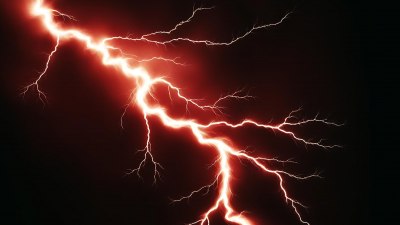The Science of Red Lightning: What Is Sprites Phenomenon
Discover the fascinating world of Sprites, the elusive red lightning phenomenon, and its scientific explanations.

The phenomenon of sprites is one of the most intriguing subjects in atmospheric science, providing a glimpse into the complexities of our planet's atmosphere. Sprites are bright, transient electrical discharges that occur high above thunderstorm clouds, appearing as red flashes of light, often accompanied by other forms of upper-atmospheric lightning. This article delves into the science behind sprites, their formation, and their significance in understanding atmospheric electricity.
History of Sprites Discovery
The term 'sprites' was coined by researchers in the late 20th century, but sightings of these luminous phenomena date back to earlier centuries. In the early 1980s, high-altitude lightning was observed more closely, leading to the classification of these dazzling electrical discharges. Initial photographs captured from the ground began to piece together this new aspect of electrical phenomena occurring in the atmosphere, but it wasn't until advanced imaging and observation technology, such as high-speed cameras, that a comprehensive understanding of sprites began to emerge.
What Are Sprites?
Sprites are a type of upper-atmospheric lightning, classified under a broader category of phenomena known as transient luminous events (TLEs). These electrical discharges occur at altitudes of 40 to 90 kilometers (approximately 25 to 56 miles) above the Earth's surface. They manifest typically as clusters of red, blue, or even purple light, often appearing in shapes resembling jellyfish, carrots, or other fantastical forms. Each sprite can last from a few milliseconds to a whole second, creating a brief but spectacular visual display.
How Do Sprites Form?
The formation of sprites is intricately linked to strong thunderstorm activity. When thunderstorms produce powerful, negatively charged lightning strikes, significant amounts of electrical charges are released into the atmosphere. These strikes can lead to an ionization effect in the upper atmosphere, where air becomes conductive as water droplets collide with ice particles within the storm clouds. When the electric field created by these conditions reaches a critical threshold, it triggers a sprite, allowing for the rapid uplift of positive charge that results in the vivid flashes of light.
The Role of Thunderstorms in Sprite Formation
Without thunderstorms, sprites would not exist. The larger and more intense the storm, the more likely sprites are to occur. The process begins when a typical thunderstorm discharges its energy through lightning. This energy release can cause an upward electrical field that can extend countless kilometers into the atmosphere. It is this upward discharge that ultimately ignites the sprite phenomenon. Researchers have observed that large storms, particularly those with high-frequency lightning activity, are the most prolific generators of sprites.
Sprites and Their Variants
Sprites are not alone in the upper atmospheric phenomena. They exist alongside several variants, primarily red sprites, blue jets, and ELVES (Emission of Light and Very Low Frequency Perturbations due to Electromagnetic Pulse Sources). Red sprites, most commonly researched, are the result of strong lightning strikes creating a rapid discharge of energy. Blue jets, on the other hand, shoot upward from the tops of thunderstorms at bright blue hues and occur at altitudes lower than sprites. Meanwhile, ELVES are enormous flashes caused by the electromagnetic pulses emitted by lightning strikes, creating discs of light that expand rapidly, often perceived as faint halos.
The Science Behind The Colors
The characteristic red color of sprites results from the ionization of nitrogen and oxygen in the upper atmosphere. When an electrical discharge occurs, it causes nitrogen molecules to become excited and emit light. The wavelength of this emitted light most closely corresponds to red, which is why sprites are often seen in these hues. The altitude at which sprites occur also plays a role in their appearance; the thinner atmosphere allows specific wavelengths of light to dominate and enhances the visibility of the red emissions.
Measuring and Observing Sprites
To study sprites, scientists utilize sophisticated observation techniques. Ground-based cameras equipped with high-speed imaging systems provide data on the frequency, duration, and morphological characteristics of sprites. Additionally, satellite imaging contributes an aerial perspective of these phenomena, letting researchers capture events and track the thunderstorms below. The use of sensitive spectrometers allows scientists to analyze the light emitted from sprites, leading to insights into the chemical compositions and dynamics involved.
Sprites' Impact on the Atmosphere
The occurrence of sprites has important implications for atmospheric physics and climate. They are related to the dynamics of thunderstorm systems and can serve as indicators of significant weather activity. By studying sprites, scientists gain a deeper understanding of the electrical processes occurring in the atmosphere, unlocking new knowledge about weather patterns and the effects of climate change. Furthermore, sprites can influence the ionosphere, the charged part of the atmosphere where radio waves propagate, making research into these phenomena essential for improving communication and navigation systems.
Sprites and Climate Change
As climate change alters weather patterns globally, the frequency and intensity of thunderstorms may also change, potentially affecting the occurrence of sprites. Some studies suggest that changes in temperature and humidity could lead to an increase in severe weather events, thus leading to more sprite occurrences. Understanding the relationship between these atmospheric phenomena and climate variations may provide valuable insights into the broader effects of climate change on the Earth’s systems.
Sprites in Popular Culture
The captivating appearance of sprites has struck the imagination of many and inspired stories, artwork, and media representations. From scientific documentaries to science fiction narratives, the idea of mysterious lightning phenomena has captured the human experience, urging many to explore further into the atmospherics of our Earth. Sprites have been a subject of interest not only in scientific circles but also among amateur astronomers and enthusiasts who chase storms and document such rare atmospheric events.
Future Research Directions
Ongoing research into sprites continues as scientists explore new observation methods and technologies to investigate the complexities surrounding these phenomena. Studying sprites can shed light on atmospheric electricity's broader implications, aiding in predicting weather events and possibly providing insights into the evolution of thunderstorms and their interactions with climate systems. Future research could involve advancements in satellite technology, deeper collaborations across disciplines, and improved theoretical models to understand better the roles that sprites may play in our atmosphere.
The study of sprites represents a fascinating convergence of atmospheric science, physics, and environmental observation. These extraordinary displays of red lightning illuminate the intricacies and wonders of our atmosphere. As researchers continue to unveil the mysteries behind sprites, their implications for understanding weather, climate, and atmospheric electricity are of paramount importance.
By studying sprites, we can appreciate the balance and complexity of the Earth's atmosphere and perhaps find ways to mitigate the impacts of changing climates on weather phenomena. So the next time a thunderstorm rumbles in the distance, look skyward; you may catch a glimpse of these stunning red lightning flashes illuminating the evening sky.











